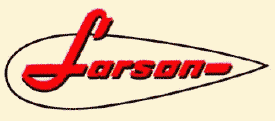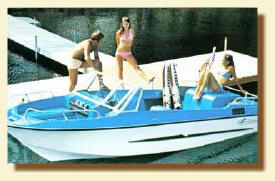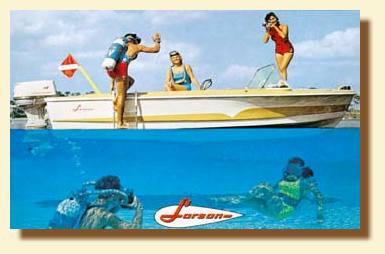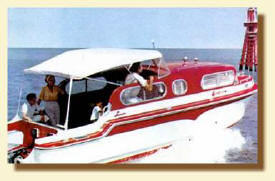Larson Brunswick Boats: Rough Seas
by Andreas Jordahl Rhude
 Third in a series of articles about Larson, Larson Watercraft, and Crestliner boats.
Third in a series of articles about Larson, Larson Watercraft, and Crestliner boats.
By the late 1950s Larson Boat Works, Inc. was on a strong footing. They had made the switch from wooden to fiberglass construction successfully and had five factories throughout North American spitting out boats.
Larson Boat Works had truly been a family affair. Paul Larson was at the helm and his wife Carol worked for many years as secretary and bookkeeper as well as office manager. Carl Jones, a brother-in-law to Paul, was one of his earliest helpers. Pauls brother Roy worked alongside him until he left to pursue his career at Larson Motor Service. Brother Lem came aboard after World War II to become sales manager. Carols brother Carl Luedke, with banking experience, joined the company as office manager. His wife Nell was an office secretary. Brother Fred was one of the original investors in Larson Watercraft, Inc. and he and Paul also had a saw milling business adjacent to the Boat Works, Larson Lumber Company. They retrieved sunken logs, deadheads, from the Mississippi and sawed them up for lumber.
 Until about 1958, Larson Boat Works was a regional boat builder, concentrating her sales on the Upper Midwest. Ed Anderson recalls that Larson Boat Works did not print many copies of their annual catalog and they often times did not exhibit at boat shows (Ed Anderson Interview, 2/8/2002). With the addition of people such as Earl Geiger, Chuck Gravelle, and Al Hegg in 1957-58, expansion to a full North American market took place. Up to 1959 Larson did not advertise in any of the national boating journals. It was in 1959 that they first began a national advertising and marketing program.
Until about 1958, Larson Boat Works was a regional boat builder, concentrating her sales on the Upper Midwest. Ed Anderson recalls that Larson Boat Works did not print many copies of their annual catalog and they often times did not exhibit at boat shows (Ed Anderson Interview, 2/8/2002). With the addition of people such as Earl Geiger, Chuck Gravelle, and Al Hegg in 1957-58, expansion to a full North American market took place. Up to 1959 Larson did not advertise in any of the national boating journals. It was in 1959 that they first began a national advertising and marketing program.
Sales tripled in 1959 compared to the previous year and they added 384 dealers. When Larson Boat Works was incorporated in January 1957, the board of directors consisted of Paul Larson president; Earl Geiger vice president; Lem Larson treasurer; and Mrs. Paul (Carol) Larson secretary.
 In late fall 1958 Popular Boating magazine sent test pilot Hank Bowman to Little Falls to give the Larson All American a try out. One reason the publication wanted to test one of these boats was the developments Larson had made which perfected the Rand Gun process of spraying chopped glass fiber and resin to form molded boat hulls.
In late fall 1958 Popular Boating magazine sent test pilot Hank Bowman to Little Falls to give the Larson All American a try out. One reason the publication wanted to test one of these boats was the developments Larson had made which perfected the Rand Gun process of spraying chopped glass fiber and resin to form molded boat hulls.
The puddles were ice covered as Bowman took the sixteen-foot All American on her test run. He rated the boat excellent for safety citing the large amount of foam and air chamber floatation built into the hull. Comfort and durability were also rated excellent in the article. The boat had lapstrakes molded into the hull below the chine and smooth surfaces above. Bowman gave the boat an above-average rating as to styling and only average when it came to adaptability of the seating and cockpit area. Overall Bowman liked the boat and gave it good marks as an all-around family boat, living up to its name.
During their visit to Canada in 1959, Her Majesty Queen Elizabeth II and HRH Prince Philip accepted a gift of a Larson All American sixteen-foot fiberglass boat. The gift came from the citizens of Cornwall, Ontario. Larson boats were made there by Courtlands Moulded Products of Canada Ltd., a licensee of Larson. The boat was presented Prince Philip, a boating enthusiast. (Boats, Sept. 1959).
 Expansion occurred again when on 01 April 1960 Larson opened a new plant at Alliance, Ohio. Several other plants had been opened in 1958-1959. They produced Larson boats under franchise/license agreements. This arrangement gave Larson a quick and low investment means to expand production.
Expansion occurred again when on 01 April 1960 Larson opened a new plant at Alliance, Ohio. Several other plants had been opened in 1958-1959. They produced Larson boats under franchise/license agreements. This arrangement gave Larson a quick and low investment means to expand production.
When Paul Larson was 66 years of age, he sold Larson Boat Works to Brunswick Corporation on 15 September 1960. Larsons sales for 1960 exceeded $5.8 million. Multifaceted Brunswick had obtained Owens Yachts earlier in the year. Owens had a subsidiary at Tell City, Indiana that made small, outboard runabouts of fiberglass construction called Cutter Boats. Brunswick felt Larson added a nice thread to their tapestry of products. Brunswick paid 60,332 shares of its common stock for Larson, valued at about $1.3 to $3.7 million. The following year Brunswick purchased Kiekhaefer Corporation, the makers of Mercury outboard and stern drive engines.
Brunswick Boats Division became the new name for the fiberglass boat builders Larson, Cutter, and Owens. Earl Geiger, former general manager of Larson became president of Brunswick Boats. Plants were consolidated and some were closed. The plants at Little Falls; Nashville, Georgia, and Alliance, Ohio were the only ones left to make Larson fiberglass runabouts for the 1961 model year (Lee Wangstad).
After the sale to Brunswick, production problems developed and quality suffered. Loyal dealers were abandoning ship. Large corporate culture was foreign to the close knit, family environment at Larson. What occurred over the next three years dismantled the core of the former Larson Boat Works. The 1961 Larson models were being produced at the two plants in Minnesota and Georgia. Cutters Tell City plant was shut down after that season (Lee Wangstad). Brunswick moved the molding of hulls and component manufacturing of both Larson and Cutter to a newly constructed plant near Warsaw, Indiana closing the recently opened plant at Alliance, Ohio. Completed parts were then shipped to Little Falls for final assembly and finishing. Decision making was also transferred from Little Falls to Warsaw. The closure of facilities and the move of management made for numerous quality problems and brought morale to an all time low.
Paul Larson had businesses interests outside of the boat works. In March 1962 he along with Earl Geiger and three Minneapolis men, applied for a bank charter in the city of Minneapolis (L.F. Daily Transcript, 12 March 1962). In June 1963 he was the head of Crestline Products, Inc. (not Crestliner Boats) of Little Falls, a maker of die castings, metal stamping, lawn sprinklers, and hand tools (L.F. Daily Transcript, 07 September 1966 & 04 April 1967).
In early November 1963 Mr. Larson and a group of local investors bought the dismantled company back from Brunswick for $160,000.00, a fraction of the price paid by Brunswick in 1960. In addition to Paul, these men included Earl Geiger, Dick Eich, Robert Phillips, Jim Madden of Maddens Resorts, Allen Hegg, and Sumner Young. Geiger became chairman and president of Larson with Paul becoming a director and consultant. The faith dealers once had in the company was slowly regaining ground, a pivotal step needed to make the revived venture a success. Paul Larsons participation was vital to this faith and trust. Brunswick also sold off their other small fiberglass boat business, Owens and Cutter. Al Hegg ultimately went on to be president and owner of Century Boats in 1968.
The new Larson Boat Works, Inc. would focus on making bread and butter boats for the middle mass market. They would concentrate their sales area on twelve states in the central portion of the country. Twenty-five workers were initially employed (L.F. Daily Transcript, 08 Nov. 1963). Their first order of business was to have molds for the hulls and other components made, since they had all been shipped to Warsaw several years earlier. Their All-American boat model was the backbone of this philosophy. An affiliated company, Larson Boats of Georgia, Inc., would make Larson brand name boats for the southeastern portion of the country.
From November 1963 until February 1964 only 100 boats were built by the new enterprise. But production increased exponentially over the next several months. Twenty-five workers were initially employed but that blossomed to 147 by May 1964 (L.F Daily Transcript, 18 May 1964). The recovery was on the way.
In the fall of 1964 Larson announced the introduction of a four-wheel drive off-road vehicle. The precursor to todays four-wheelers; it was designed by Bill Richards of Minneapolis. The Larson Off-Roader was meant to be used by sportsmen to reach backcountry locations (L.F Daily Transcript, 15 September 1964). At the same time Larson was considering diversification into the building of aluminum boats. This idea never materialized.
Sales increased from $1.5 million in 1964 to $4.5 million the following year. In December 1965 the company purchased Northland Ski Manufacturing Company and C.A. Lund Company maker of Northland water skis, snow skis, and hockey sticks. Earlier in the year Larson had purchased a major interest in Polaris Industries, the maker of Polaris snowmobiles. The corporate name was changed to Larson Industries, Inc. effective 03 January 1966 and the headquarters was moved from Little Falls to the Twin Cities.
Larson Industries, in June 1966, entered into a management contract with Glasspar Boat Company of Santa Ana, California. Larson took over operations while ownership remained with Glasspar. Larson hired Donald Schultheis to oversee Glasspar. Glasspar was one of the original builders of fiberglass boats and they had plants in Santa Ana; Nashville, Tennessee; and Petersburg, Virginia (L.F Daily Transcript, 23 June 1966). Just four months later Larson purchased the assets of Glasspar for 116,340 shares of common stock. Glasspar had 500 employees and had built 7,600 boats in 1965 with sales of $6 million with a net loss of $767,333.00 (L.F. Daily Transcript, 25 October 1966). The new Glasspar Division of Larson Industries, Inc. continued to build their own line of boats. The Glasspar name was slowly phased out and was totally abandoned by 1977.
Sales volume of the combined operations now owned by Larson amounted to $11 million in 1966. Larson decided to sell her interests in Polaris and try their luck at making their own line of snowmobiles. By September 1966 Larson snowmobiles were being assembled by Paul Larsons Crestline Products (L.F. Daily Transcript, 07 September 1966 & 04 April 1967). The venture was a failure, as they just could not compete with existing builders. The first Larson snowmobile that was made still exists. It is located in John Monahans Boat Works Museum in Little Falls.
More diversification occurred during the same period. In October 1966 they opened a new facility at St. Peter, Minnesota to make the Northland brand fiberglass skis. The firm bought LeCenter, Minnesota based Brinktun, Inc. in July 1967, a maker of ping-pong and pool tables. Only a few months later Larson Industries purchased Rolite, Inc. of Grantsburg, Wisconsin. Rolite built folding travel trailers and camper tops for pickup trucks. 1967 sales soared to a whopping $31 million. However, all the divestiture drained resources and capital from the core business: boats. Bankruptcy was inevitable.
In 1970 a major portion of Larson Industries was sold to Wilson Sporting Goods of Chicago, a Pepsi company. They added three of their own directors to the Larson board. Two years later in December 1972 Wilson sold its shares to General Boats Partnership, a group of Minnesota investors. The group consisted of a number of former Larson employees and owners. Sumner Young became chairman, and new directors were Earl Geiger, James Madden, and Robert J. Phillips.
Geiger had been with Larson off and on since 1957. At that time Larson still owned subsidiaries that made pool tables, hockey sticks, and travel trailers in addition to the Larson and Glasspar boat lines (L.F. Daily Transcript, 19 & 21 December 1972). By 1973 Larson Industries had two manufacturing facilities building boats, Little Falls and Nashville, Georgia. Both Larson and Glasspar brand names were made at Little Falls. All other boat facilities had been disposed of previously.
Labor problems began in the mid-1970s and a strike began in March 1975. In August of that year Larson Industries declared chapter eleven bankruptcy. They were finally released from those proceedings by the court in May 1978, however, not before a number of tumultuous years. Ed Anderson, a long time Larson and Crestliner employee, said that Thompson Boat Company owner Saul Padek attempted to purchase Larson during this dark period for pennies on the dollar. Padek appeared before the bankruptcy court arguing his case. He was turned down (Ed Anderson Interview, 08 February 2002). Padek, a 1960s and 1970s corporate raider, most likely would have closed down operations and liquidated the assets of Larson.
First National Bank of Chicago began foreclosure proceedings against Larson Industries in August 1975. They demanded immediate repayment of a $5.5 million loan. By November Larson was in receivership with James Michaelson as court appointed receiver (L.F. Daily Transcript, 07 November 1975). His first task was to fire all but a few of the remaining Larson workers. The Nashville, Georgia plant was ultimately closed down as well.
Continued in the next issue
Sources:
~ Paul G. Larson letter, undated (from files of Shirley Hanson, daughter)
~ The Real Runabouts by Bob Speltz
~ Peshtigo (WI) Times
~ Marinette (WI) Eagle Star
~ Little Falls (MN) Daily Transcript
~ John Monahan, Little Falls, MN
~ Lee Wangstad, Nisswa, MN
~ Paul Mikkelson, Wilmar, MN
~ Ed Anderson Interview, 2/8/02
~ Larson All American by Hank W. Bowman.
~ Popular Boating. Feb. 1959.
~ Larson Boats history, undated unpublished timeline
~The Heritage of Leadership: The Story of Larson Boats
by Larson Boats ã 1988
~ American Dreamboats: An illustrated History of Larson Boats
~ The Boats, and Their Times by Laura Sommers ã 2000
~ Brunswick Corporation Annual Reports 1960, 1961, 1962, 1963
~ Minnesota Manufacturers Directories
~ Boats magazine

